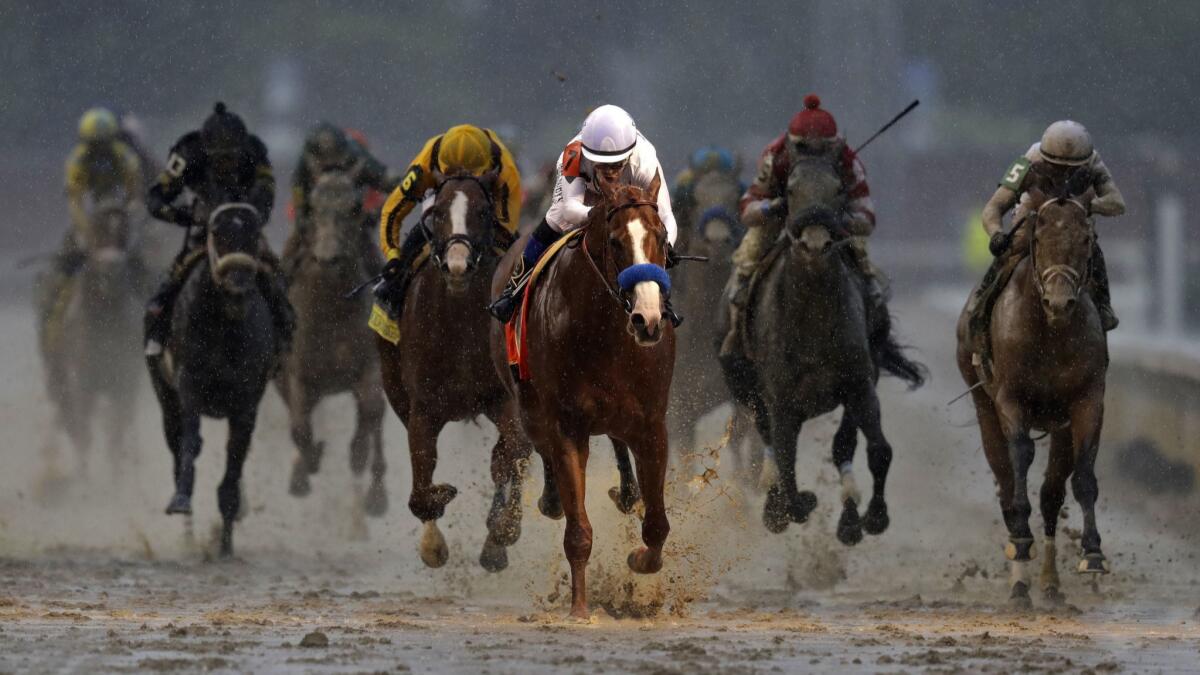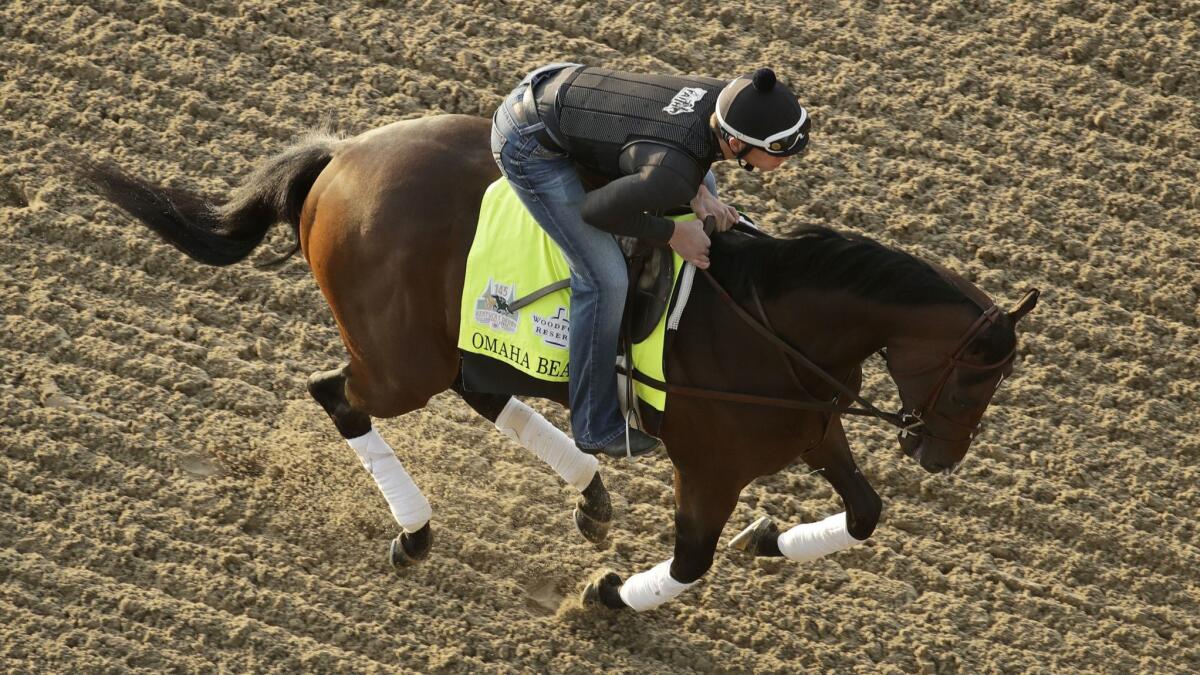The favorites are on a roll in the Kentucky Derby

- Share via
Reporting from LOUISVILLE, Ky. — Horse racing is the original sport ruled by sabermetrics. Play the percentages here, find value in the arcane stat there. Hunches are mostly plays for suckers.
But there is one statistic that has held true in racing, in perpetuity: The favorite wins about a third of the time. Anything else is an anomaly. But it seems of late that the real anomaly has been the most important race in the sport — the Kentucky Derby.
The favorite has won the Kentucky Derby the last six times. And that began 13 years after the favorite lost on the first Saturday in May for 20 straight years.
Making sense of all this is a little like trying to find a needle in a pile of horse feed.
Mike Battaglia, who has been making the morning line for the Kentucky Derby since 1975, is less impressed by the six in a row than the steak from 1980 to 1999, when the favorite was beaten each time.
“It’s just the way racing is,” Battaglia said. “Six [favorites] in a row is strange but not that unusual. But 20 in a row is crazy. It’s unthinkable. You try and sit here and try and think what happened. Could [favored] jockeys run bad races 20 years in a row? Nobody can give you a reason for it. I certainly can’t.”
In the eight years prior to the two-decade dry streak, there were six favorites that won, including Secretariat, Seattle Slew and Spectacular Bid. Another favorite in that stretch, Alydar, was beaten by Affirmed.
The current steak of favorites goes back to Orb in 2013. He was followed by California Chrome, American Pharoah, Nyquist, Always Dreaming and Justify. American Pharoah and Justify won the Triple Crown. Nyquist entered the Derby undefeated.
Jon White, a racing historian who also does the morning line at Santa Anita, sees it as more than just chance.
“It’s not a coincidence that ever since the points system came in 2013 that this is happening,” White said. “If it were just two or three you could call it a coincidence. The key has been to see how the winner has done early in the race.”
Prior to the points system, horses’ earnings were used to determine the field of 20 entrants. It allowed horses to accumulate wads of earnings as 2-year-olds. The points system rewards horses that peak just before the Kentucky Derby.
“The points system has kept the 2-year-old speedballs out of the race,” White said. “If you focus on the races after Orb [who came from far back], California Chrome, American Pharoah, Nyquist, Always Dreaming and Justify were all just sitting off the pace, second or third in the early going.
“The Derby is won in the final furlong. People get this picture of horses closing down the long Churchill [Downs] stretch. But the profile of the Derby winner, historically, is you can win from far back but you have to make your move early. Fifty-three of the last 56 winners were first or second with a furlong to go.”
White also has a theory that the expanded field of 20 has helped the best horses rise to the top, mitigating the chance of an upset.
“Now, [the best horses] have the tactical speed,” White said. “So, when the pace is not that hot, the competition toward the back can eliminate itself, especially if two or three of the main competitors get in some traffic trouble.”
Battaglia doesn’t completely agree.
“I don’t buy that,” Battaglia said. “If you put 20 horses out there the odds on the weaker horses diminish. The good ones will still move forward.”
White also recognizes the streaky nature of things.
“We just get runs of things,” White said. “We had runs of Triple Crown winners in the ’30s and ’40s but didn’t in the ’50s and ’60s. Then we had three in the ’70s and then nothing in the ’80s, ’90s and 2000s. … Now, we’re on a run of favorites. How long will it last? Who knows?
Sign up for our horse racing newsletter »
“You can say we’ve had six straight winning favorites and that should increase the chance that it will end. But each race is its own dynamic. What happened in the last six Derbies has no relevance on this year.”

Omaha Beach, trained by Richard Mandella, is almost a lock to be the favorite unless he draws the No. 1 post, the most difficult spot to run from.
Battaglia will have all the odds done by the time the draw starts Tuesday morning and is unlikely to change them based on post position.
“I quit modifying it” based on post, Battaglia said. “If I had time and could sit down for an hour, then I might change them. But it’s too tough to try and do it on the fly, unless they draw the one hole.”
Battaglia said jockey Mike Smith’s choosing to ride Omaha Beach over Roadster was “huge.” Smith rode Justify to the Triple Crown last year.
“I think it’s going to be Omaha Beach” as the favorite, Battaglia said. “Game Winner is going to be a huge player too. He’s going to be dead fit.
Game Winner is trained by Bob Baffert, who has five Kentucky Derby victories, including the last two. Baffert also has Roadster and Improbable entered in this Derby.
“If Baffert only had one horse and it was Game Winner, he might have been the favorite.” Battaglia said. “But all the Baffert money is going to be split among his three horses. That’s another reason Omaha Beach might be the favorite.”
Click here (or type in this url: lat.ms/2wVt90g) to sign up for our free horse racing newsletter.
More to Read
Go beyond the scoreboard
Get the latest on L.A.'s teams in the daily Sports Report newsletter.
You may occasionally receive promotional content from the Los Angeles Times.











